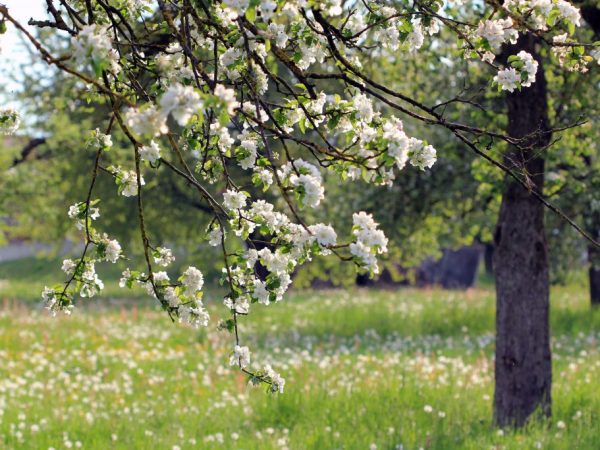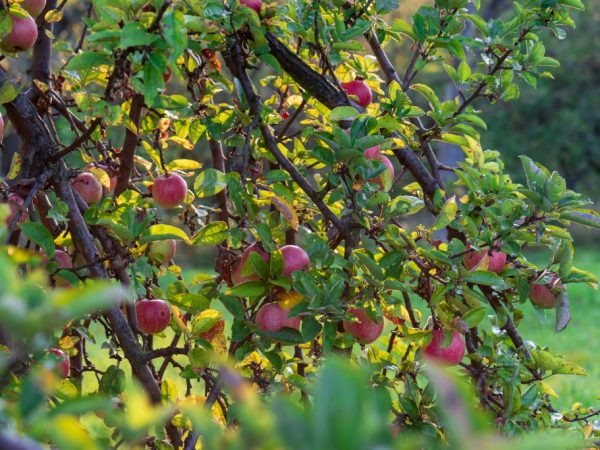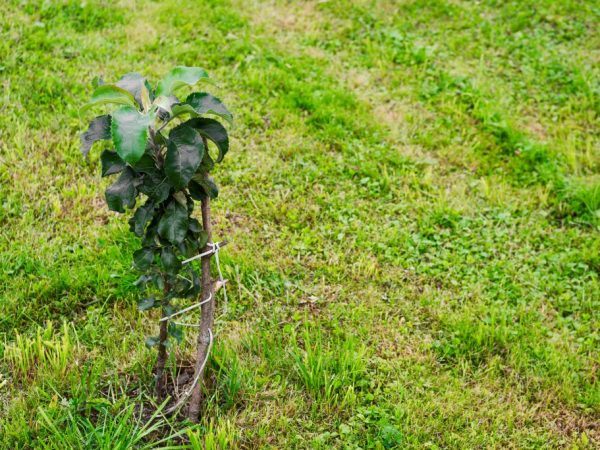Features of growing a standard apple tree
The standard apple tree is a favorite variety of many gardeners. It has an even trunk, which looks like a cane driven into the soil, and on top of it there are many falling branches or a spherical "cap" of leaves. Of course, her appearance is pleasing to the eye. This can be achieved by grafting or pruning.

Features of growing a standard apple tree
Varieties
All varieties of this culture have one thing in common - the decorative part of the tree is raised above the ground and is the highlight of the garden. Weeping forms are the most common among apple trees. The height of the stem can vary.
Calvil snow
Apple trees of this variety have a round crown, thick. The flowers are large in size and resemble a saucer. The leaves are small. The fruits are roundish, light green. In September, after ripening, they turn yellowish. The peel on apples is thin, with a glossy shine. The pulp is white, granular, the structure of the fruit is similar to the VEM variety.
Snowy Calvil is growing rapidly. Productivity - about 250 kg / ha. Trees bear fruit every year. The quality and quantity of the crop is affected by the intake of a sufficient amount of moisture, but it is worth remembering that its excess can cause a fungal disease - powdery mildew.
The variety has medium frost resistance. Resistant to the main apple disease - scab.
Amateur gardeners prefer this apple for its juicy, tasty fruits, which are great for harvesting juice. One of the peculiarities of the variety is its hard peel, thanks to which apples are stored for up to 5 months.
Imbelyana
The tree is compact, up to 4 m tall, frost-resistant. The crown is beautiful, wide, easy to shape. The apple tree is not sick with scab. Imbelyana bears the first fruits in the 4th year. The yield indicator is above average. This variety is early autumn, so the fruits are harvested for storage or processing in September.
Fruits of excellent presentation, the same size, weighing 100 g. Round shape, white-yellow color. The texture is fine-grained. The pulp is snow-white. There is a light apple flavor. The pulp is juicy enough, not fresh. Possesses high taste. The dessert taste makes it very appetizing.
If the necessary conditions are met, the harvested crop is stored for 2 months (until December).
Gem
The tree has a rounded crown, medium height. It tolerates a harsh winter well, is resistant to diseases. Suitable for growing in central Russia, Bashkiria. In Siberia, it is recommended to cultivate an apple tree in stanza form. The tree is immune to scab and is resistant to moth and moth.
Requires a thorough spring pruning. The gem pleases with large fruits and their quantity, because has a high yield. Ripe apples are harvested at the end of September. Under appropriate conditions, in a cool, dark place, they can be stored until spring.
Oval apples. Weight varies from 160 to 300 g.The fruits are greenish-yellow in color with red stripes that cover almost the entire apple. The pulp is white-green, fine-grained. The taste is refreshing, pleasant, sweet and sour. A light apple aroma is felt.
Summer red
The tree is undersized with a pyramid-shaped crown. Cold-resistant variety, high-yielding, immune to scab. The apple tree does not tolerate stagnant water at the roots. The crop gives from 4-5 years and annually. Fruiting of a mixed type (on the branches of both annual and perennial).
Fruits weighing 200 g, light green in color. They are almost completely covered with a reddish blush in the form of strokes. The pulp is tender, creamy white, with a slight graininess. The apple aroma is pronounced.
The taste is sugar-rich, rich, with a slight hint of sourness. The assessment of taste is high - 4.8 points. Fruits are harvested at the end of August, and stored for about 2 months.
Candy

Ripe apples do not fall off the tree
Apple trees are fast growing. The fruiting stage begins in the 4th year. The crown is in the form of a sphere, powerful, does not deform from hanging apples. Early variety. Apples ripen in August, do not crumble from the branches. The sweetmeat brings a high and regular yield.
When fully ripe, the apples reach medium size. They have tender, sweet flesh and a subtle caramel flavor. Taste score - 4 points. They are stored for a relatively short time, but they are great for homemade preparations and juice production.
Erimar
Medium height tree. The shape of the crown is rounded with drooping branches. The Erimar apple tree requires regular pruning, because prone to thickening. It is characterized by high winter hardiness. Flowering occurs late, the tree is "afraid" of spring frosts.
Apples weighing 40-80 g, light yellow. They have a striped blush all over the surface. The pulp is grainy, creamy, with a rich aroma. The taste is sweet. Fruiting - up to 70 kg per tree. On the branches, apples are kept even when overripe.
Fruits are stored for up to 3 months. Erimar is beautifully combined with landscaping in the park. On the plots, a tree is grown to create blanks in the form of jam or jam.
Red early
The early Red apple tree is distinguished by its early maturity, strong immunity, which allows it to resist fungal diseases, and a good indicator of winter hardiness. The crown is spreading, the tree is medium-sized. Reaching an average size (150 g), the fruits ripen by the end of summer.
The color of the apples is greenish with a bright red blush. The texture of the white pulp is grainy, juicy, aromatic. The sweet taste is diluted with a slight hint of sourness. High marketability and dense peel contribute to long-term storage and easy transportation. Apples are in demand among buyers.
Ruby Dooks
The species belongs to winter early-growing varieties. A feature of the Rubinovye Duki standard apple tree is its high resistance to severe frosts. Indicators of productivity, transportation and storage are high. The fruits ripen in mid-autumn.
Apples weight - 170-190 g. Fruits are dark red. The taste is sour with a hint of sweetness. The pulp is firm. The tree ripens in September - October. Fruits are stored for about six months, until the end of May.
Mom's cups
Medium-sized tree with a lush crown. Mama's apple-tree belongs to the varieties of national selection. The zest of the species is the unusual shape of the fruit - elongated-conical. The crown is drooping, well developed.
The apple tree is high-yielding. With timely pruning, it has a high level of resistance to fungal diseases, except for scab.
Apples ripen in autumn. The tree tolerates frost well. The apples are identical to each other, burgundy in color, sweet in taste. The pulp is juicy with a delicate aroma. Taste score - 4.5 points. Standard apple trees have the ability to quickly recover in case of frost.
Landing

The tree needs sunlight
Just as when planting ordinary apple trees, you should first choose the most suitable place where the tree will be located.A draft-free area with ample sunlight is ideal.
Apple trees are compact in structure, which means their convenient neighborhood in a small area, even if they are planted along a garden path.
The planting pit should be prepared in the fall. It needs to be dug out (it should be about one meter by one meter in order to prevent bending and breaking of the roots) and fertilized with phosphorus and potassium fertilizers (mix 50 g of these substances and distribute evenly over the soil).
If the soil does not have a rich nutrient composition, then organic fertilizer should also be applied (peat, sapropel, humus, compost in the amount of one bucket).
In early spring, as soon as the soil thaws, a standard apple tree is planted. Before the procedure, the tips of the roots should be trimmed to speed up the adaptation of the tree to the new place. Next, you need to place it in a hole, sprinkle it with earth, first straightening the roots, and water generously.
Loose surfaces can be covered with mulch. Planting is carried out so that the distance between the trees is at least 1 m, the yield depends on this.
Care
Such an apple tree needs constant attention, because timely care will help maintain a decorative appearance, increase disease resistance and yield.
Thus, the apple tree needs:
- watering. During the growing season, the tree should be provided with moisture, watering it 2-3 times a week with 20 liters of water. After harvesting, water-charging irrigation is carried out;
- prevention and treatment of diseases. Before the buds ripen on a clear day, it is necessary to trim the crown and spray it in order to prevent infections and insects. The apple tree is fertilized with nitrogen dressings (the solution is obtained by mixing 500 g of urea with 10 liters of water). When freezing it is sprayed with the preparation "Epin" (1 ampoule for 5 liters of water);
- when buds are formed on a young tree just entering the fruiting period, flowers should be cut off. In the second year, 10 inflorescences are left, then they are kept half as small until the tree reaches the age of 5 years;
- loosening the soil. The area of the trunk circle should always be loosened or mulched. Depending on where the tree is planted, different materials are used to cover the soil. If this is a garden, then you can take compost, buckwheat husks or straw. On decorative flower beds, sawdust (dyed or natural) and crushed bark are used. It should be remembered that sawdust causes depletion of the soil, taking nitrogen from it to feed bacteria, therefore, a larger amount of this fertilizer should be used during the growing season;
- fertilizer. Before the start of the growing season, spraying is carried out with a mixture of urea (700 g) and copper sulfate (50 g), diluted with 10 liters of water. Spring feeding - a week after flowering (1 tbsp. L. Urea per 5 l of water) and after fruit setting (1 tbsp. L. Urea per 5 l of water). In August, superphosphate is sprayed (100 g per bucket of water), which promotes the formation of new buds. Root feeding - once in the summer (5 g of sodium humate and 600 g of nitrophosphate sprinkle in the periosteal circle) and in the fall (350 g of superphosphate and 300 g of potassium);
- the standard apple tree is pruned before the growing season, in early spring or late autumn. In the summer, it is allowed to remove dried or cracked branches with covering over the cut points with garden pitch;
- autumn care. After harvesting the fruits, the apple trees are fed and treated against fungi and pests (for this, a 1% solution of Bordeaux liquid is used), which "live" around the tree and on the surface of the trunk. 4 top sheets must be cut by a third;
- care in the winter. The trunk is lubricated with a lime solution to prevent bark burns and protect against small rodents. To make the tree easier to endure the drop in temperature, snow is trampled down in the trunk circle and laid under the trunk.
Benefits
The standard culture has the following advantages when growing:
- due to its unusual and neat appearance, it can be used in landscape design;
- such a tree develops more actively, getting more sunlight and better ventilation;
- the apple tree can also be cultivated in small areas of the garden.


